My Shopping Bag
Your shopping bag is currently empty.
Recently Viewed
Would you like to pair it with your medal?
Free delivery
- Total (Excluding VAT)
- 0
Half a century has passed since Van Cleef & Arpels, founded in France in 1906, opened its first boutique in Japan (1973). The Maison has always enjoyed a special connection with traditional Japanese art and culture. Today, this dialogue between the French decorative arts and ancient Japanese artistic craftsmanship continues.
In 2004, one of Van Cleef & Arpels’ historical motifs, the butterfly, was reinterpreted in a new form: a lacquered Butterfly clip. This piece is the fruit of the Maison’s collaboration with Japanese artist Junichi Hakose. In his workshop, located in Wajima City, Ishikawa Prefecture, Mr. Hakose combines the area's traditional handicraft, Wajima-nuri, and his own vision of lacquer art.
His incorporation of elements such as maki-e painting (gold or silver sprinkling) or raden resonates deeply with Van Cleef & Arpels’ attachment to tradition and Métiers d’art. Since then, the collection has been constantly enriched with new designs of lacquered butterflies embodying the harmonious fusion of the Maison’s heritage and traditional Japanese craftsmanship.
Neither Mr. Hakose nor his loved ones were harmed by the earthquake that struck Japan on January 1. However, the artist’s workshop sustained severe damage. The Maison has since been in constant contact with Mr. Hakose and his team to aid in rebuilding efforts.
“We have been honored to work alongside Junichi Hakose for the past 20 years,” said Nicolas Bos in 2024, Former President of Van Cleef & Arpels. “Today, as a Maison committed to preserving savoir-faire, we are intent on extending to him our full support.”
This encounter between Jewelry and traditional Japanese culture gave rise to a singular collaboration. After having been made – in France – from yellow and white gold, mother-of-pearl and diamonds, these butterflies are carefully hand decorated by Mr. Hakose with Japanese lacquer and maki-e technique. Each unique pattern of these limited-edition pieces is created on the butterfly wings through a sweeping sequence of techniques: from the Japanese lacquer to the decorations (maki-e, raden, rankaku and more), the lacquered butterfly is a long-term undertaking.
For the past 20 years, these lacquered butterflies have demonstrated continuous evolutions sparked by the dialog between these two cultures. As Mr. Hakose explains, "Europeans traditionally add new features, while Japanese have always tried to reduce or omit things. The outcome of this dialog is visible in the design of the lacquered butterflies. While Japan's culture has its own charm, I would like to understand French culture and facilitate communication."

Lacquered Butterfly Fukiyose AM clip, 18K yellow gold, white mother-of-pearl, lacquer, diamonds
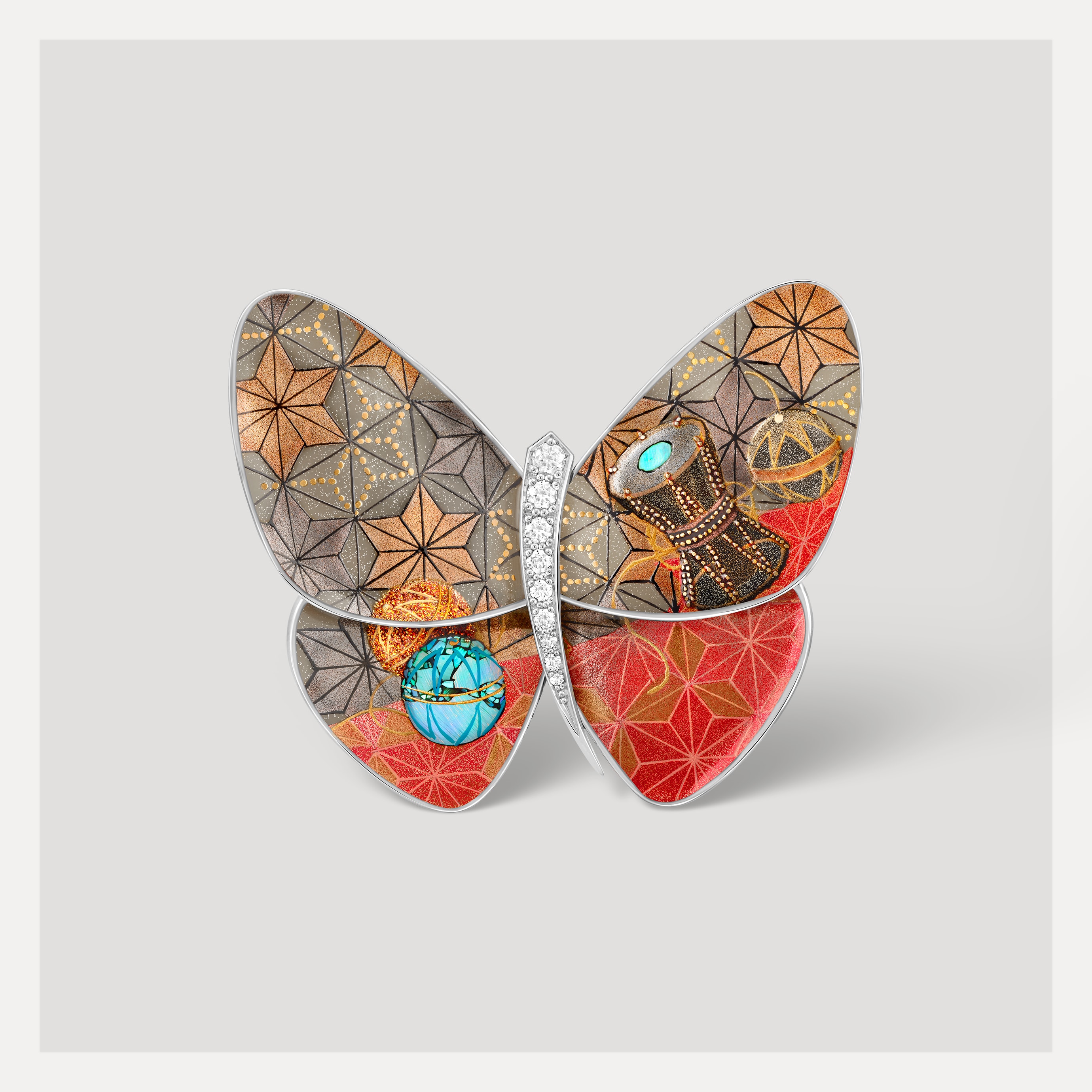
Lacquered Butterfly Tsuzumi AI clip, rhodium plated 18K white gold, gray mother-of-pearl, lacquer, diamonds

Lacquered Butterfly Hanashobu AT clip, 18K yellow gold, white mother-of-pearl, lacquer, diamonds
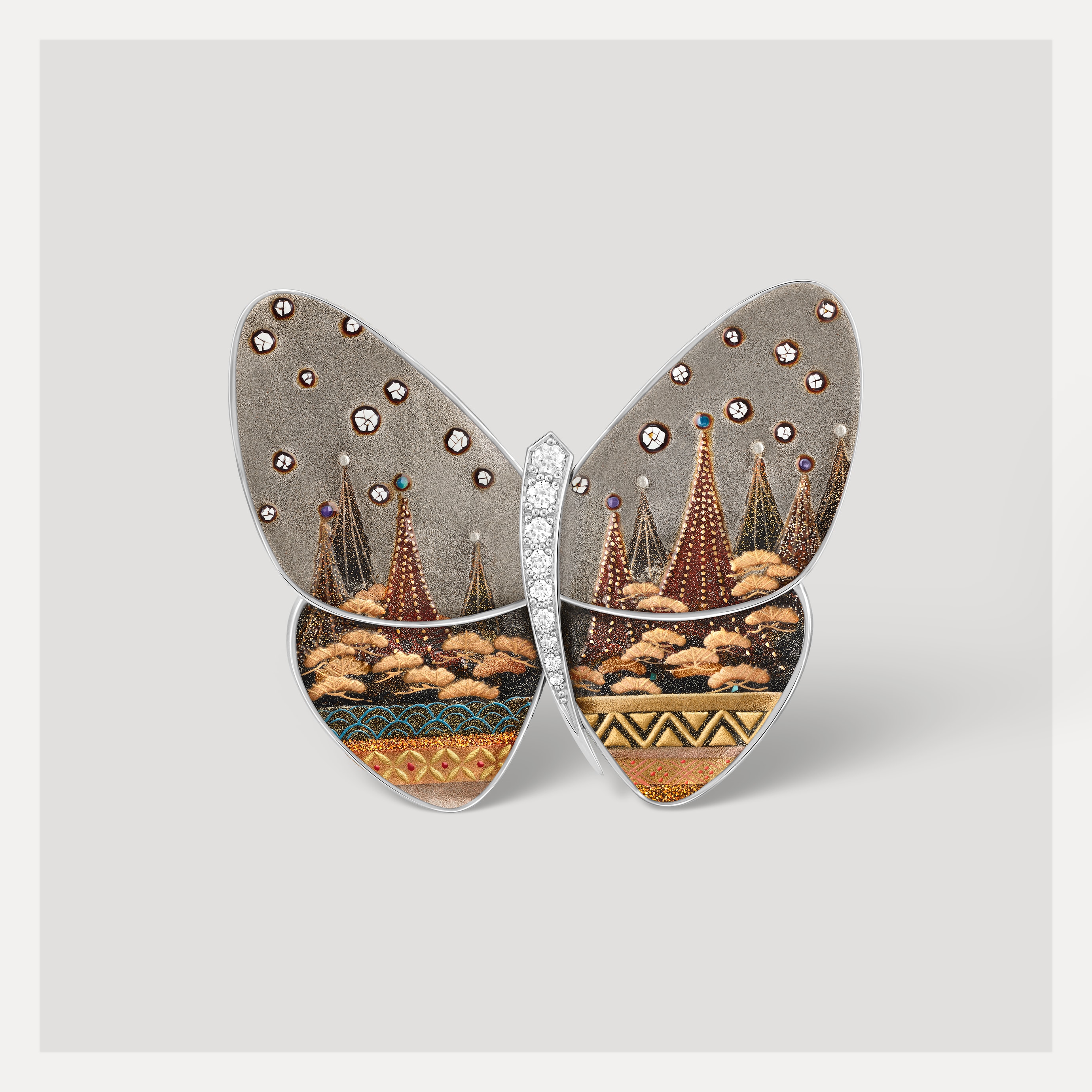
Lacquered Butterfly Yukizuri AP clip, rhodium plated 18K white gold, gray mother-of-pearl, lacquer, diamonds
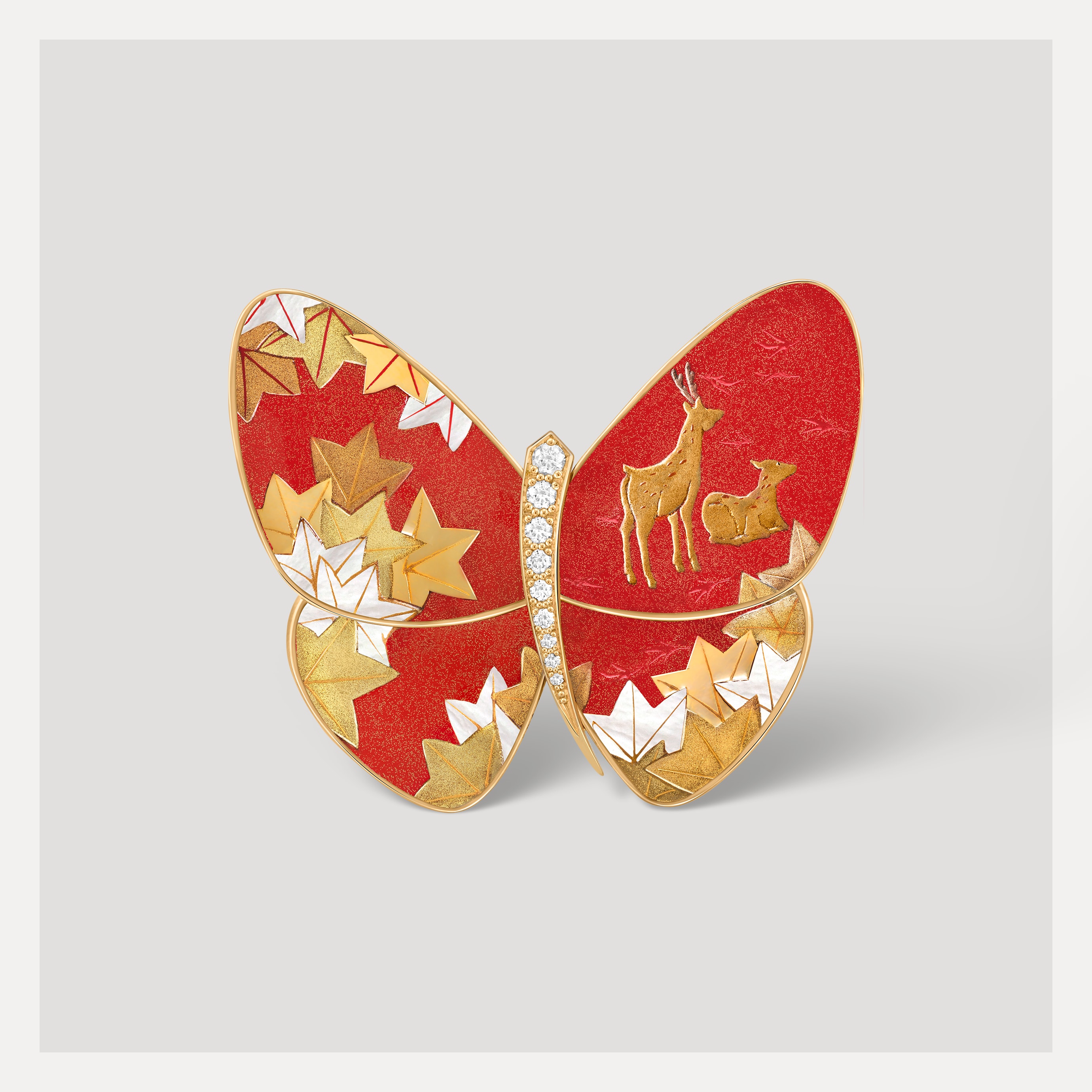
Lacquered Butterfly Akino AN clip, 18K yellow gold, white mother-of-pearl, lacquer, diamonds
Since the collection's beginnings, 46 different designs have been created thanks to Mr. Hakose’s constant involvement in drawing “Japanese items.” At first, the artist focused on traditional patterns, but in recent years he has conceived modern scenes, including buildings and landscapes for example. They reflect Mr. Hakose’s belief that every work of art has a story to tell. “There’s the story of the production process, including the techniques used,” he says, “and another one about the motif created through them. This is part of the jewelry universe, as attested by Van Cleef & Arpels during its history.”
The many pieces created testify to the universal character of this collaboration. One reflects Mr. Hakose’s modern interpretation of the traditional Japanese patterns, such as the Ichimatsu Edo Komon, reminiscent of European city streets, while another evokes year-end celebrations with designs echoing yukizuri ropes, the traditional method of protecting trees from snow in Hokuriku (northern Japan). As lacquer takes on different tones depending on the ambient light, motifs are open to interpretation and serve as bridges to different cultures, producing new stories on their own.
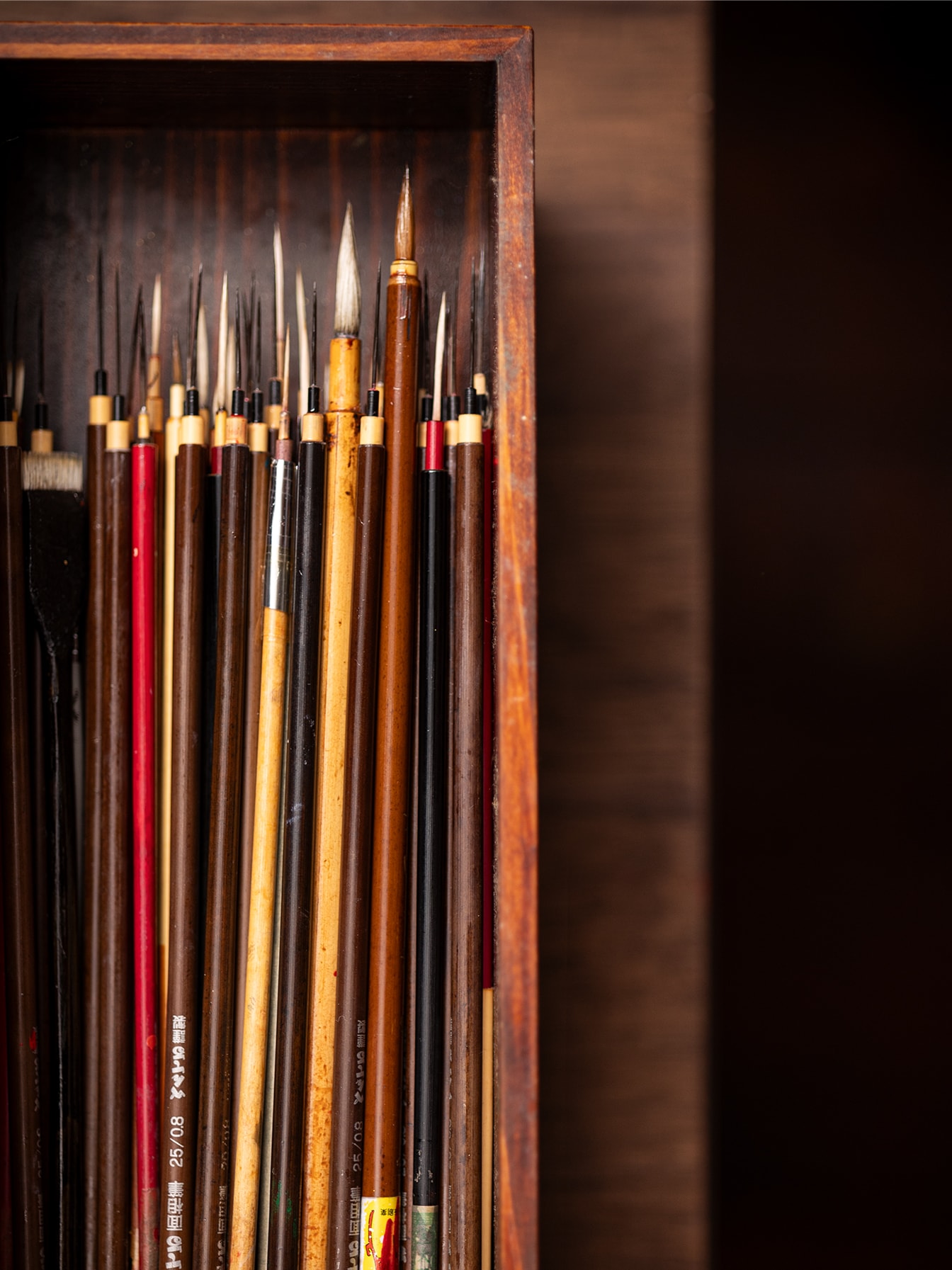

Nature has offered a rich and dearly cherished source of inspiration for Van Cleef & Arpels since its founding. Creations have always been infused with vitality and movement, whether evoking the changing seasons or the poetry of a flower in bloom. Among these traditions, butterflies have appeared as a prominent motif, sometimes interpreted through abstract contours. The ethereal flutter of their wings and their magical metamorphosis have consistently nurtured the Maison’s imagination.
Japanese techniques made it possible to transcribe this animal’s lively dance on such delicate and fine pieces. While eggshell fragments large and small must be meticulously arranged to form a specific pattern, the use of an ultra-thin brush to draw infinitesimally fine lines in a single stroke requires concentration and expertise. According to Mr. Hakose: “I had a hard time when drawing hand drums and balls. If the line is not taut and tense, it won’t work; it won’t feel alive. To achieve the result I want, the line should be not simply traced, but tightly pulled with the brush.”
Also, in the process where he creates motifs with finely crushed quail eggshells, Mr. Hakose skillfully arranges and adheres fragments, some barely larger than a speck of dust, to create a pattern. Among the pieces the Japanese artist creates, these lacquered butterflies, particularly diminutive, use various advanced techniques that interact to imbue their surfaces with dynamism and vitality.

Applying lacquer maki-e technique – Machi butterfly clip

Precious metal sprinkling – maki-e technique – Machi butterfly clip
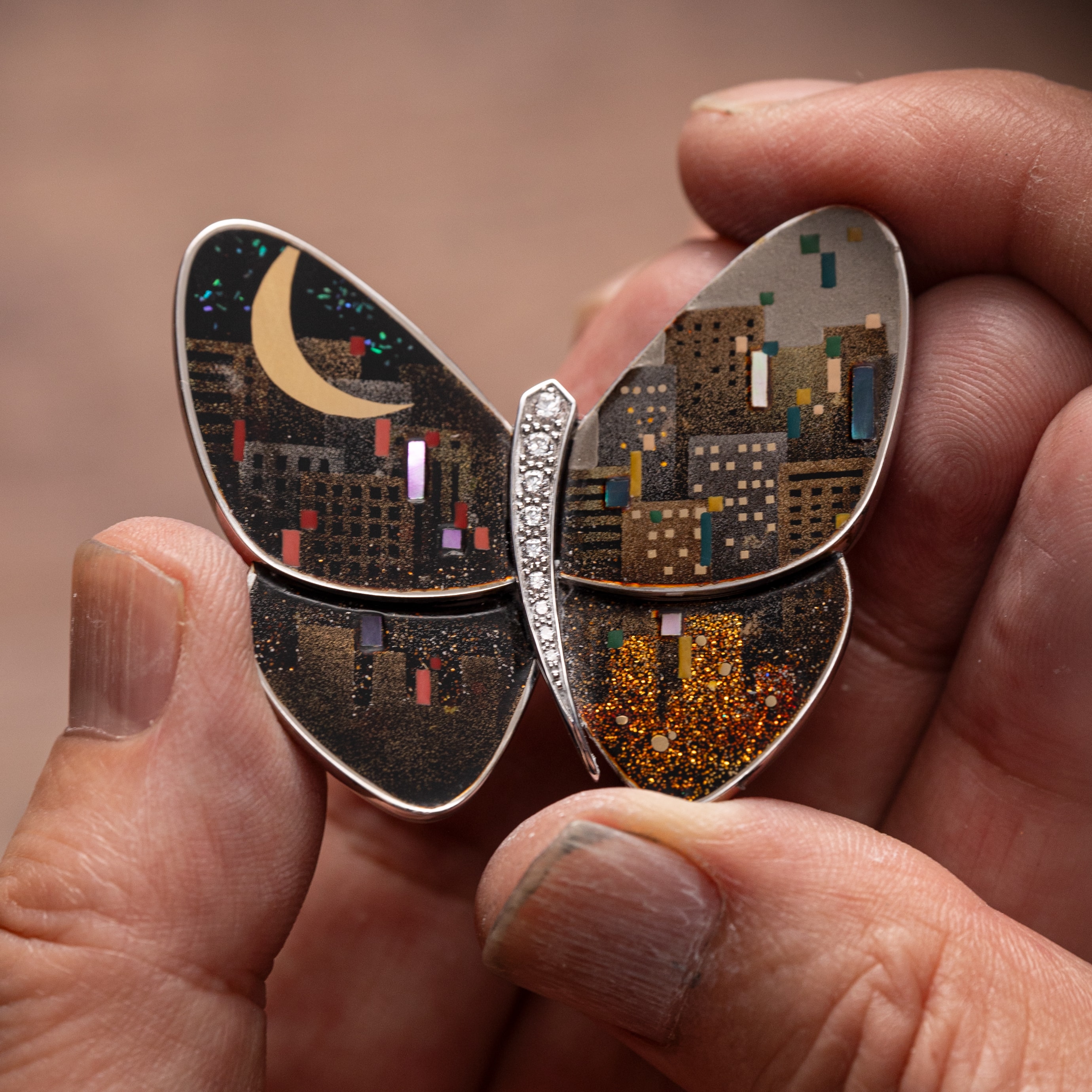
Machi butterfly clip

Eggshell marquetry – rankaku technique – Cho butterfly clip

Placing eggshells – rankaku technique – Cho butterfly clip
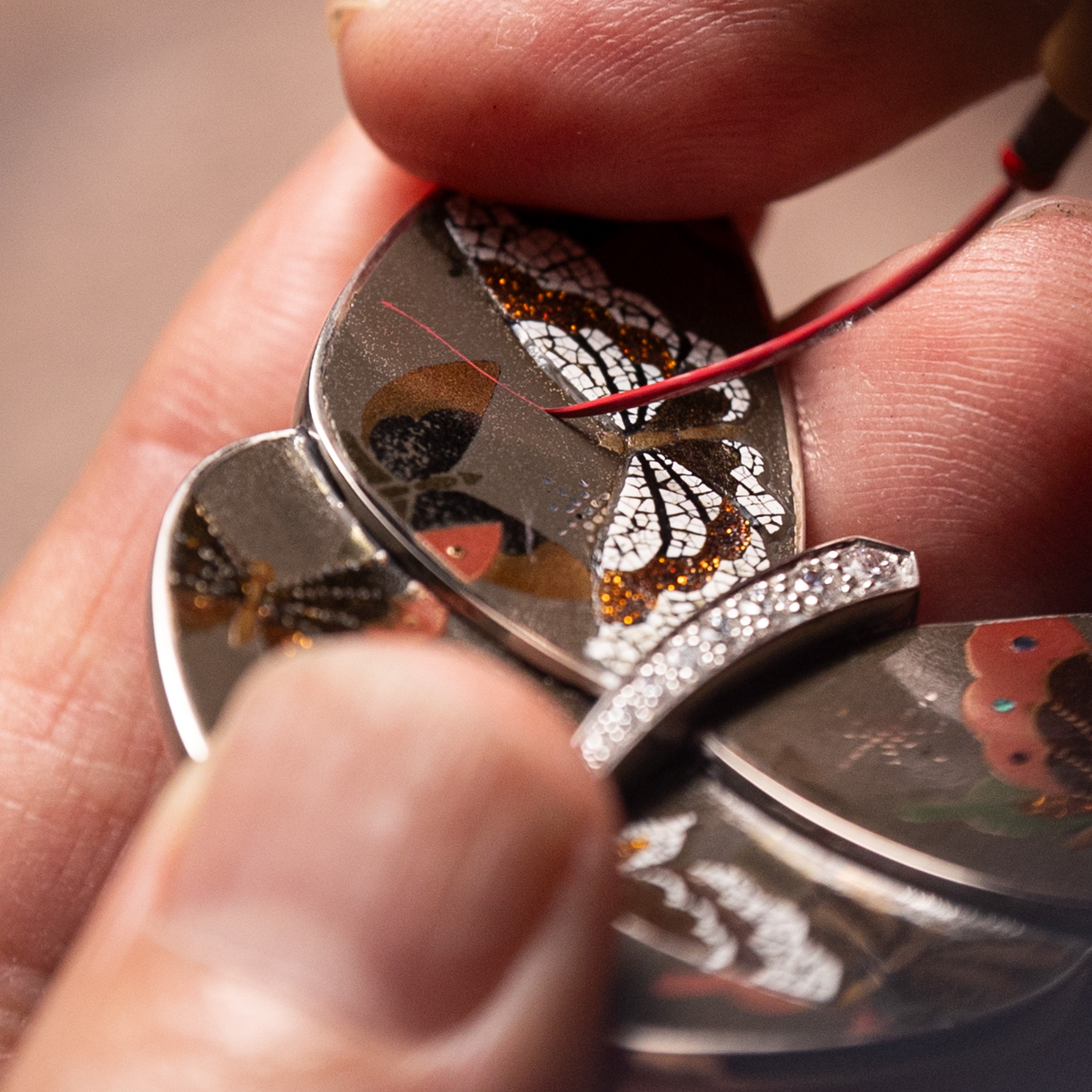
Final Painting - Cho Butterfly clip
French and Japanese craftsmanship share the idea of creating “objects that combine allure and functionality.” Just like jewelry, whose sparkle increases when worn, the beauty of lacquerware is also enhanced when used. In the words of Mr. Hakose, “Even when I draw a traditional pattern using traditional techniques, I want to make something current or something that will live in the future. That's what it means to pass down traditions.” As such, these lacquered butterflies, Mr. Hakose's first jewelry creations, offer a rare opportunity for a different country’s culture to stimulate Japan's traditions and encourage a quest for new aspects.
These lacquered butterflies, which are now flying all over the world, attest to the fruitful collaboration between Japan and France. In the future, they will certainly continue their metamorphosis, ever stimulating each other's traditions.

Junichi Hakose is a Japanese lacquer artist from Wajima City, Ishikawa Prefecture. In 1975, he started an apprenticeship under the supervision of maki-e lacquer painting master Masaru Tanaka. Mr. Hakose began working independently after a five-year training period. He has mastered the techniques of lacquer painting, maki-e, and raden, becoming a master of contemporary lacquer expression based on his own sensibility.